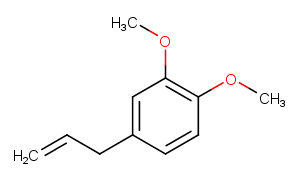Methyl eugenol
| Code | Size | Price |
|---|
| TAR-T3S2259-100mg | 100mg | £104.00 | |||||||||||||||||||||||||||||||||||||||||||||||||||||||||||||||||||||||||||||||||||||||||||||||||
| Special offer! Add £1 to your order to get a TargetMol CCK-8 Kit. Read more here. | |||||||||||||||||||||||||||||||||||||||||||||||||||||||||||||||||||||||||||||||||||||||||||||||||||
Quantity:
| TAR-T3S2259-1mL | 1 mL * 10 mM (in DMSO) | £107.00 | |||||||||||||||||||||||||||||||||||||||||||||||||||||||||||||||||||||||||||||||||||||||||||||||||
| Special offer! Add £1 to your order to get a TargetMol CCK-8 Kit. Read more here. | |||||||||||||||||||||||||||||||||||||||||||||||||||||||||||||||||||||||||||||||||||||||||||||||||||
Quantity:
Prices exclude any Taxes / VAT
Overview
Regulatory Status: RUO
Shipping:
cool pack
Storage:
-20℃
Images
Documents
Further Information
Bioactivity:
1. Methyleugenol (ME) is a natural constituent of the essential oils of a number of plants widely used in foodstuffs as flavouring agents, in view of the carcinogenic potential of ME, the need to check its presence in food products with effective analytical methods. 2. Methyleugenol has insecticidal properties. 3. Methyleugenol can inhibit the production of nitric oxide and decreased the protein expression of inducible nitric oxide synthase, it down-regulates the production of pro-inflammatory cytokines in the ischemic brain as well as in immunostimulated mixed glial cells; indicates that methyleugenol could be useful for the treatment of ischemia/inflammation-related diseases. 4. Methyleugenol has cytotoxicity and genotoxicity. 5. Intravenous (i.v.) treatment with methyleugenol (ME) in either anesthetized or conscious rats elicits hypotension, an effect that seems related to an active vascular relaxation rather than withdrawal of sympathetic tone. 6. Methyleugenol has antinociceptive effect on the second phase of formalin-induced pain, may be due to the inhibition of N-methyl-d-aspartic acid (NMDA) receptor-mediated hyperalgesia via GABA(A) receptors. 7. Methyleugenol has elaxant and antispasmodic actions on guinea-pig isolated ileum.
CAS:
93-15-2
Formula:
C11H14O2
Molecular Weight:
178.231
Pathway:
Membrane transporter/Ion channel; Neuroscience
Purity:
0.9816
SMILES:
COc1ccc(CC=C)cc1OC
Target:
GABA Receptor
References
Choi Y K , Cho G S , Hwang S , et al. Methyleugenol reduces cerebral ischemic injury by suppression of oxidative injury and inflammation[J]. Free Radical Research, 2010, 44(8):925-935.



